Abstract
OBJECTIVE: To examine the implications of serious and chronic health problems on the willingness of enrollees to switch health plans if they are dissatisfied with their current arrangements. DATA SOURCE: A large (20,283 respondents) survey of employees of three national corporations committed to the model of managed competition, with substantial enrollment in four types of health plans: fee-for-service, prepaid group practice, independent practice associations, and point-of-service plans. STUDY DESIGN: A set of logistic regression models are estimated to determine the probability of disenrollment, if dissatisfied, controlling for the influence on satisfaction and disenrollment of age, race, education, family income and size, gender, marital status, mental health status, pregnancy, duration of employment and enrollment in the plan, number of alternative plans, and HMO penetration in the local market. Separate coefficients are estimated for enrollees with and without significant physical health problems. Additional models are estimated to test for the influence of selection effects as well as alternative measures of dissatisfaction and health problems. DATA COLLECTION: Data were collected through a mailed survey with a response rate of 63.5 percent; comparisons to a subsample administered by telephone showed few differences. PRINCIPAL FINDINGS: In group/staff model HMOs and point-of-service plans, only 12-17 percent of the chronically ill enrollees who were so dissatisfied when surveyed that they intended to disenroll actually left their plan in the next open enrollment period. This compared to 25-29 percent of the healthy enrollees in these same plans, who reported this level of dissatisfaction and 58-63 percent of the enrollees under fee-for-service insurance. CONCLUSIONS: Switching plans appears to be significantly limited for enrollees with serious health problems, the very enrollees who will be best informed about the ability of their health plan to provide adequate medical care. These effects are most pronounced in plans that have exclusive contracts with providers. We conclude that disenrollment provides only weak safeguards on quality for the sickest enrollees and that reported levels of dissatisfaction and disenrollment represent inaccurate signals of plan performance.
Full text
PDF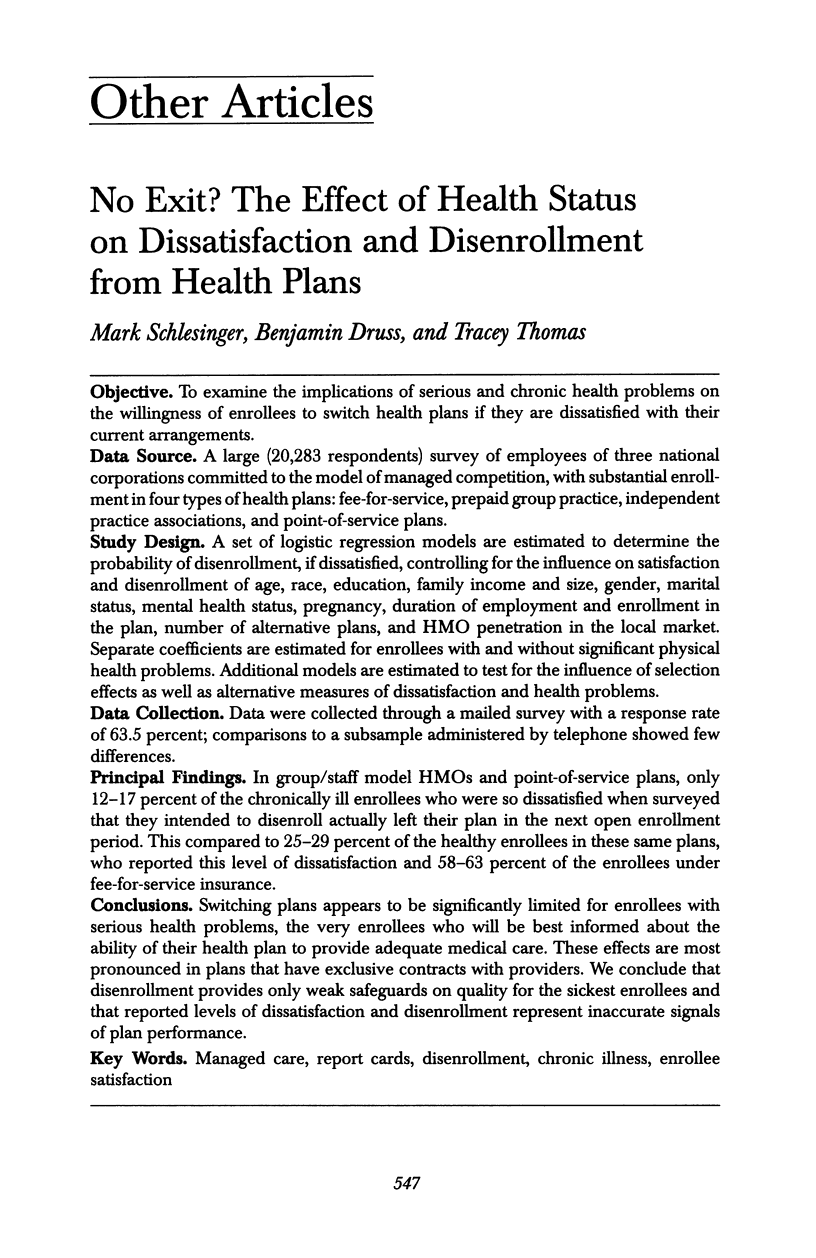
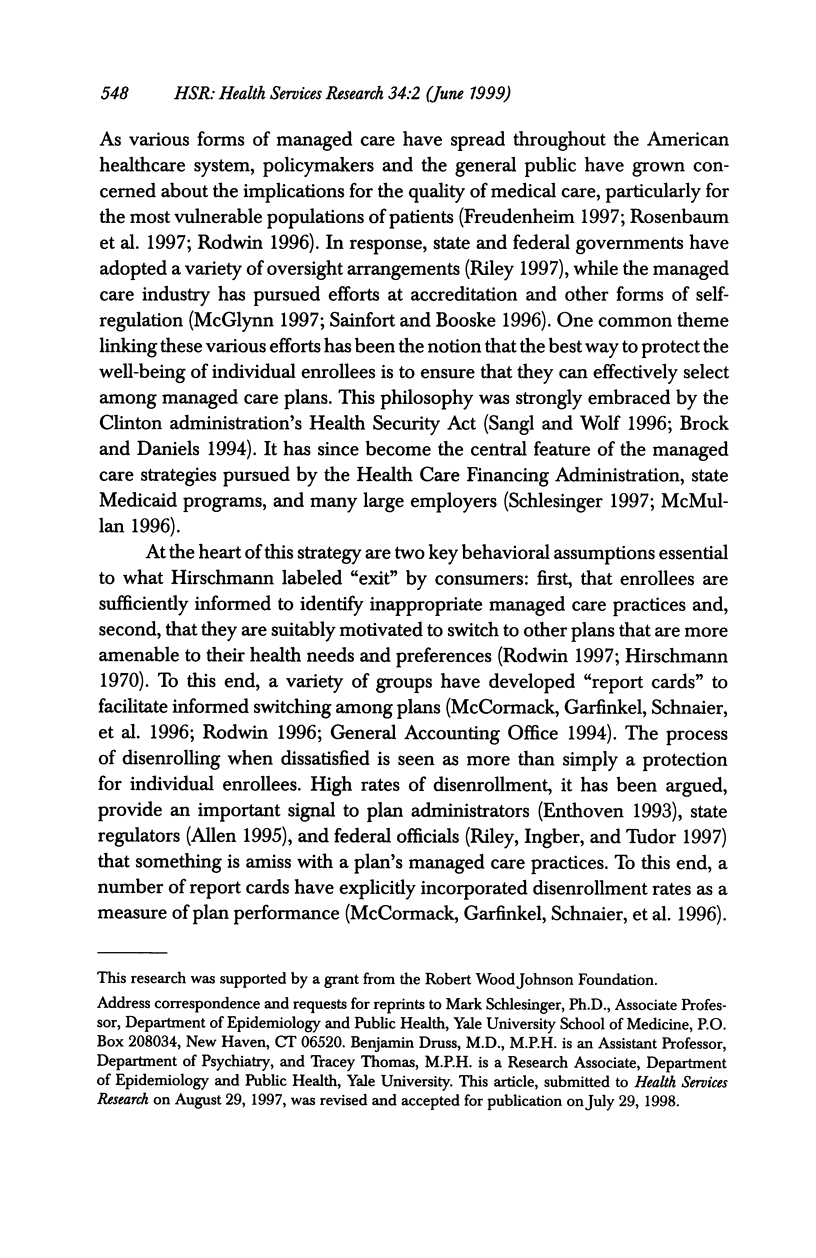
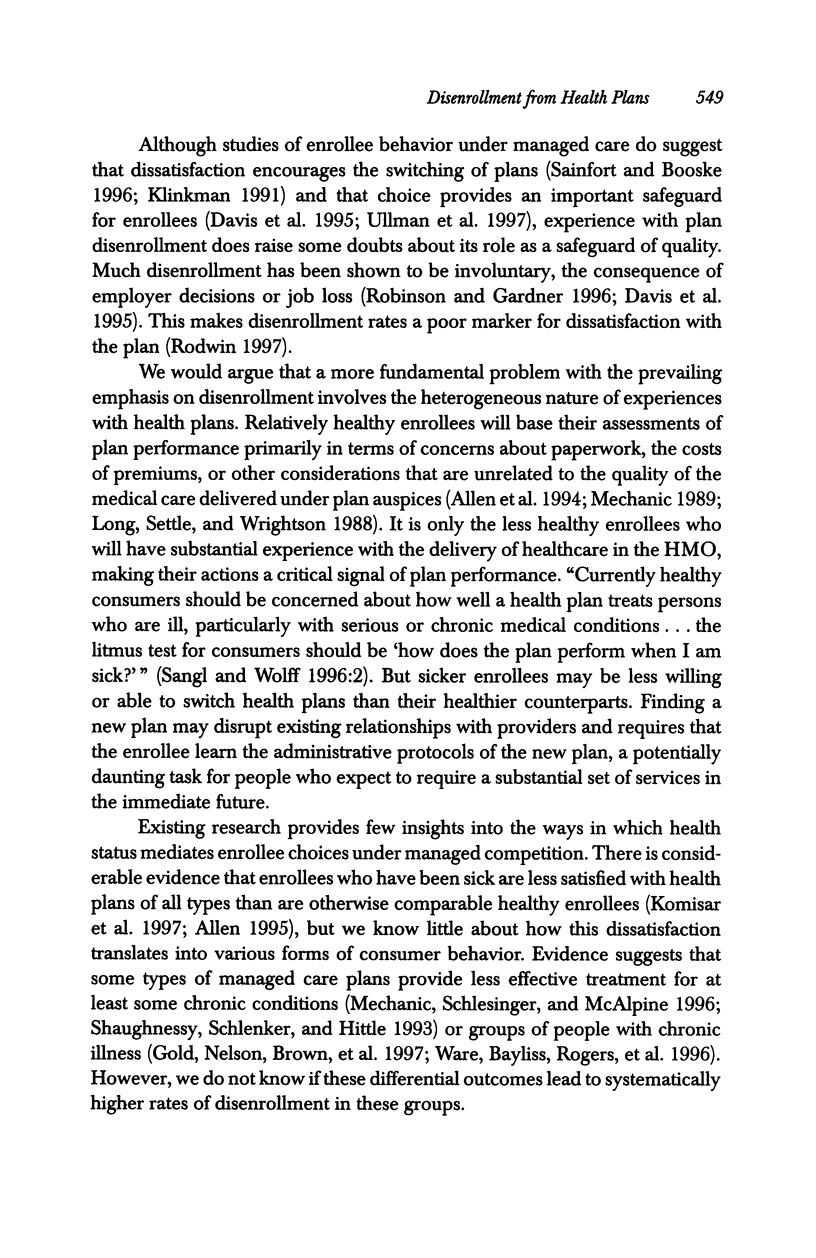
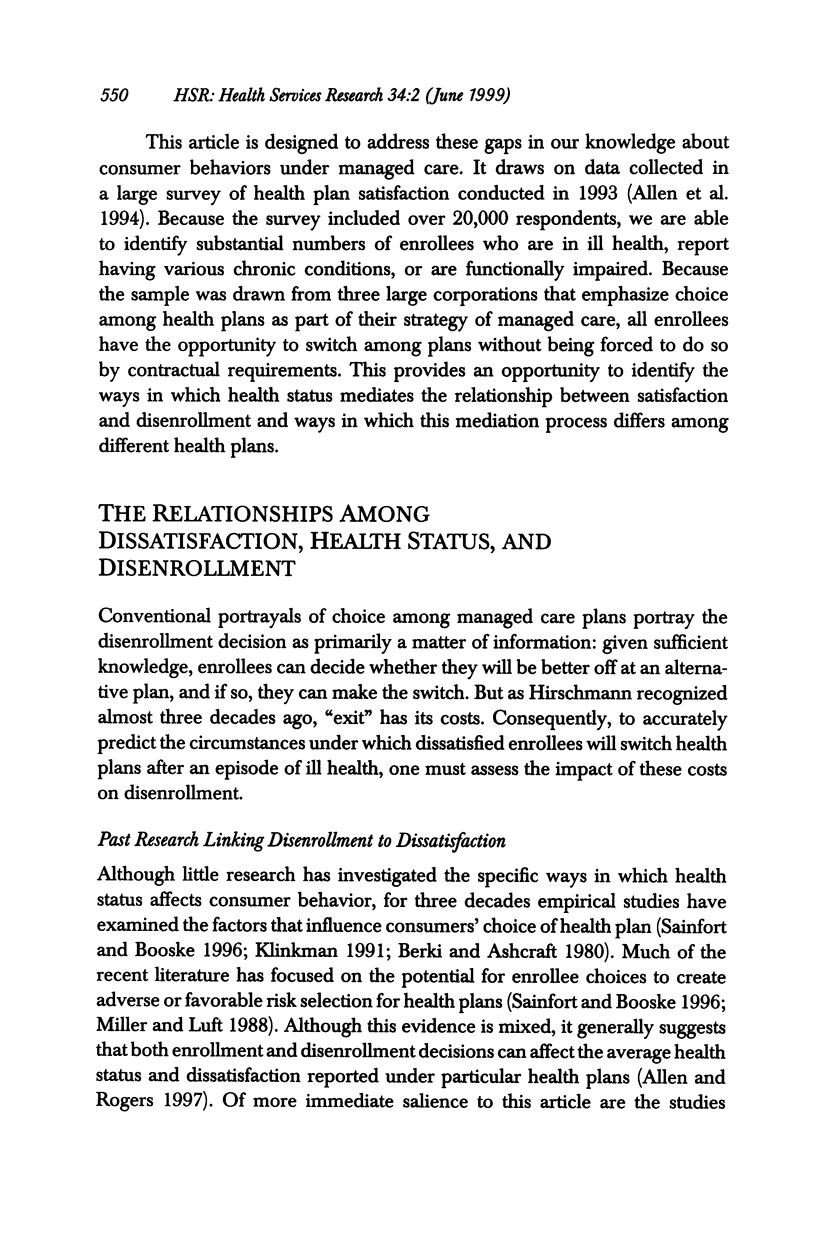
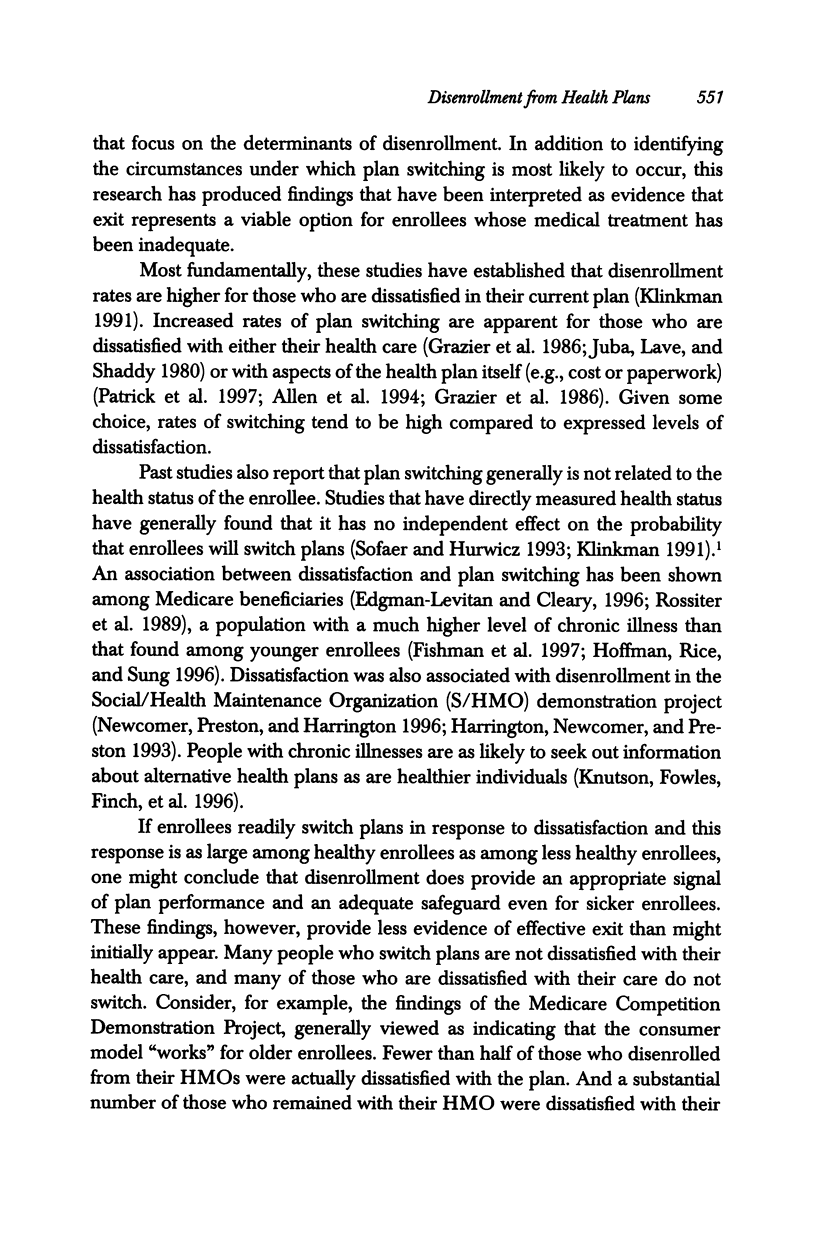
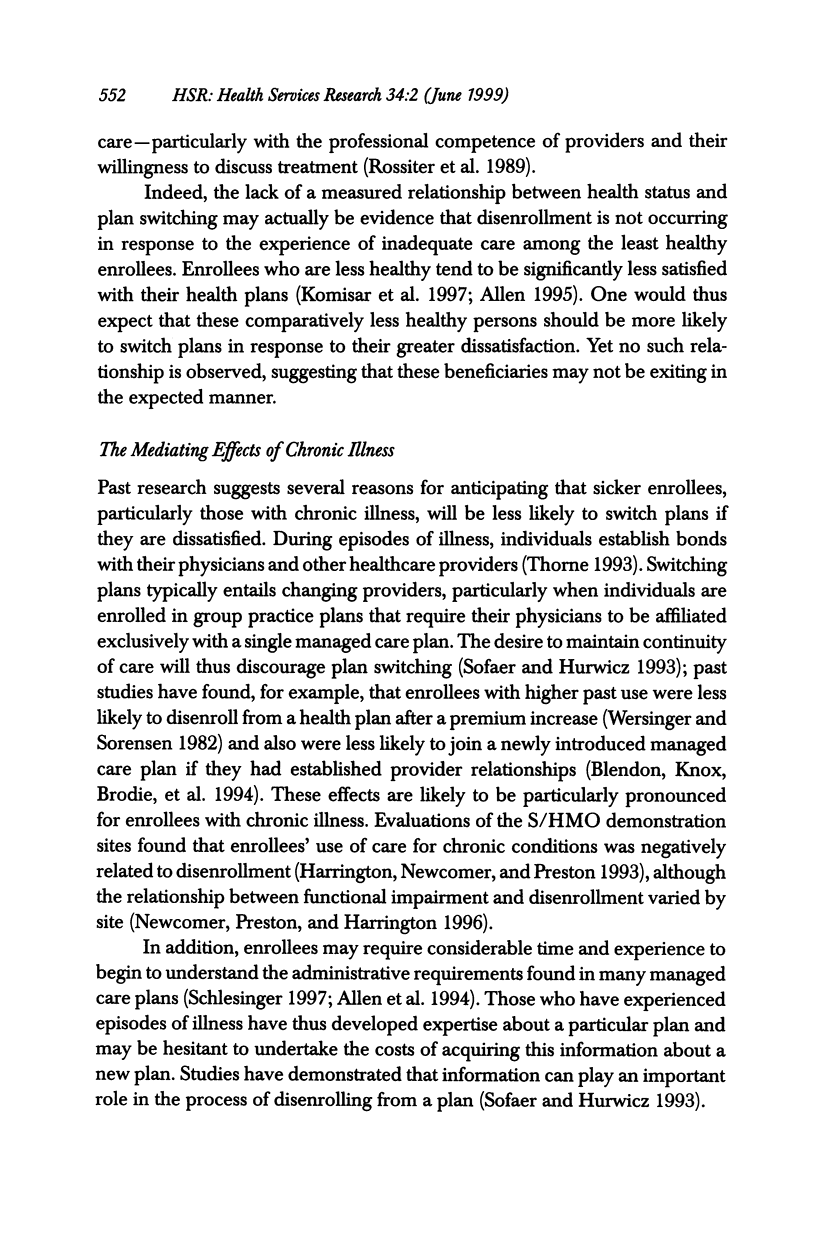

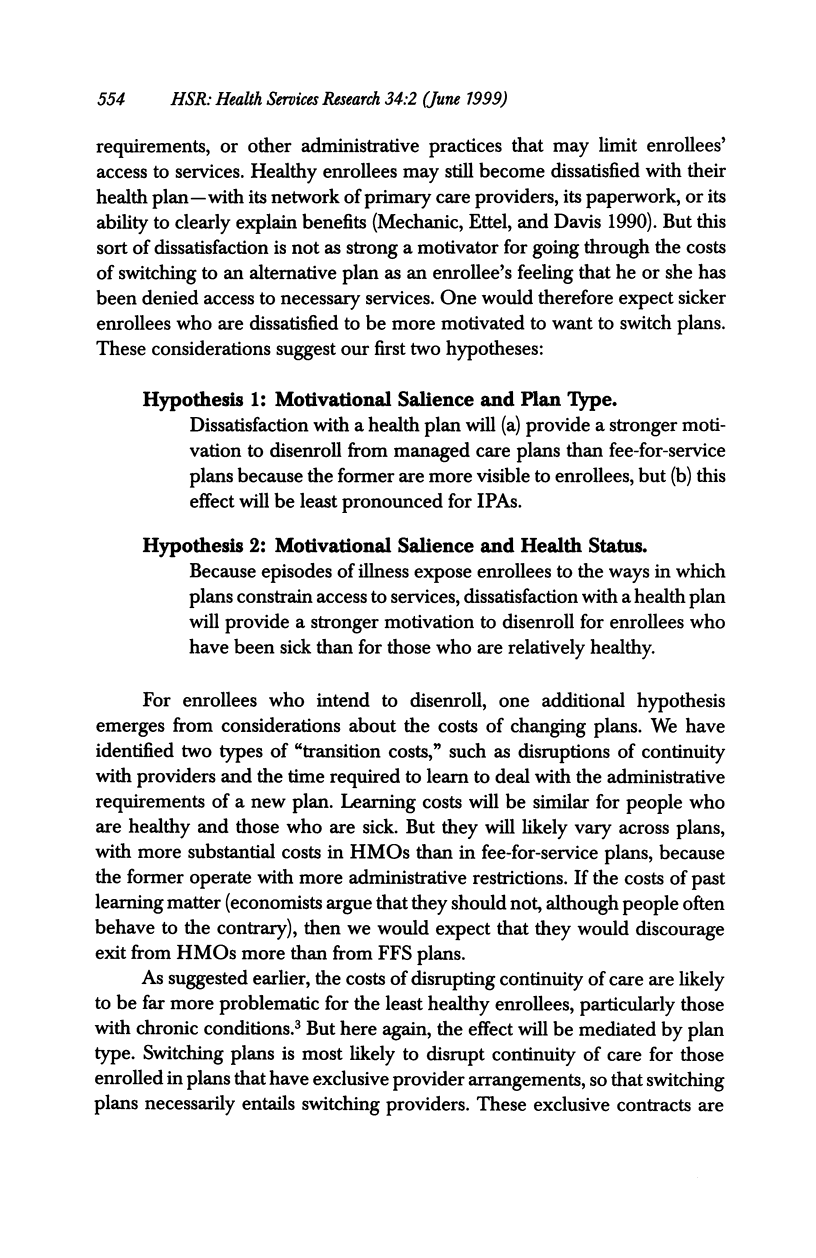
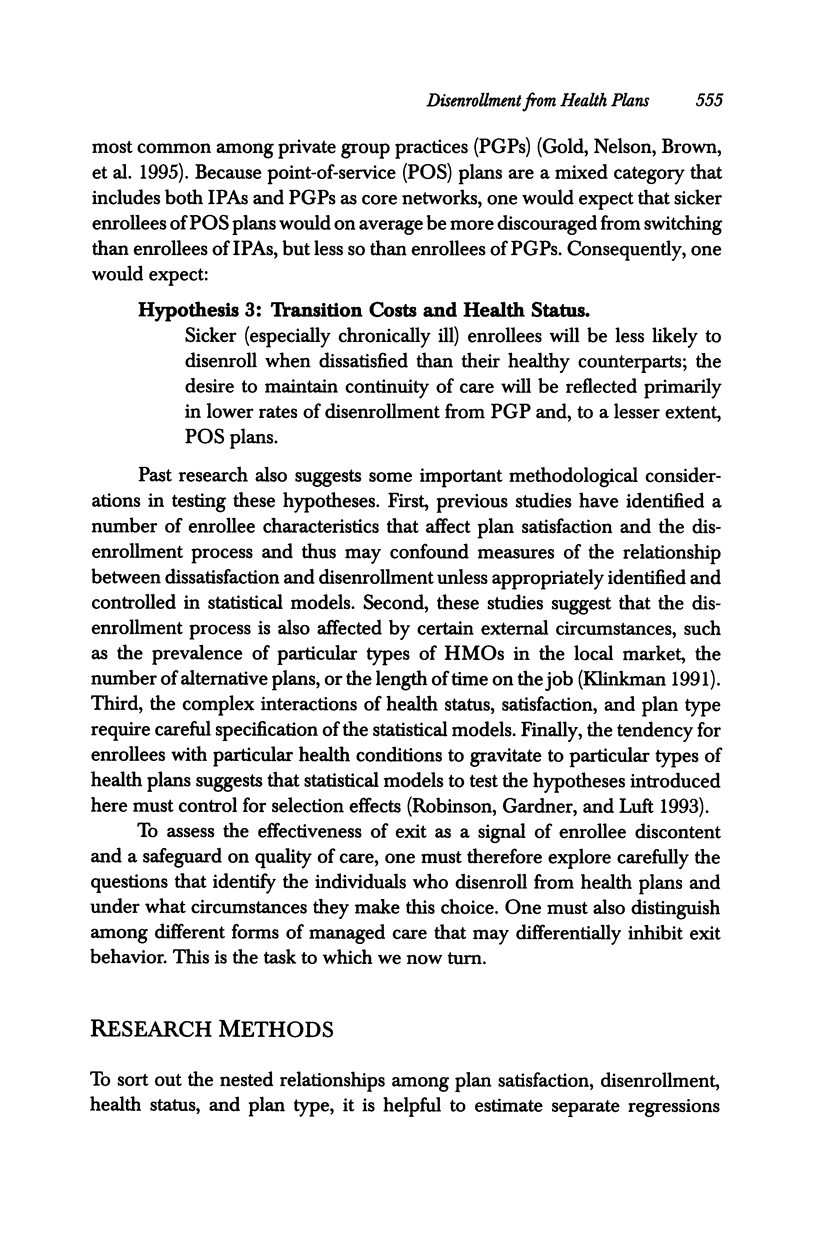
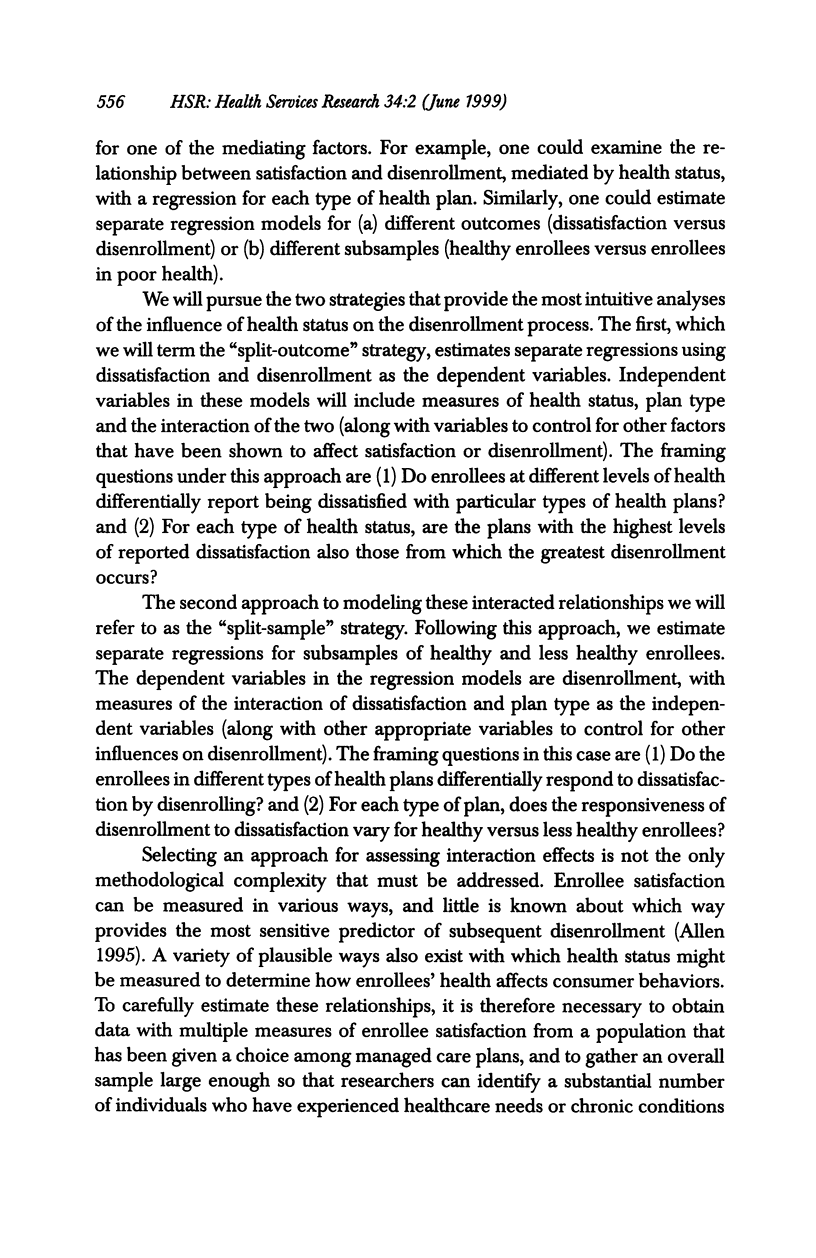
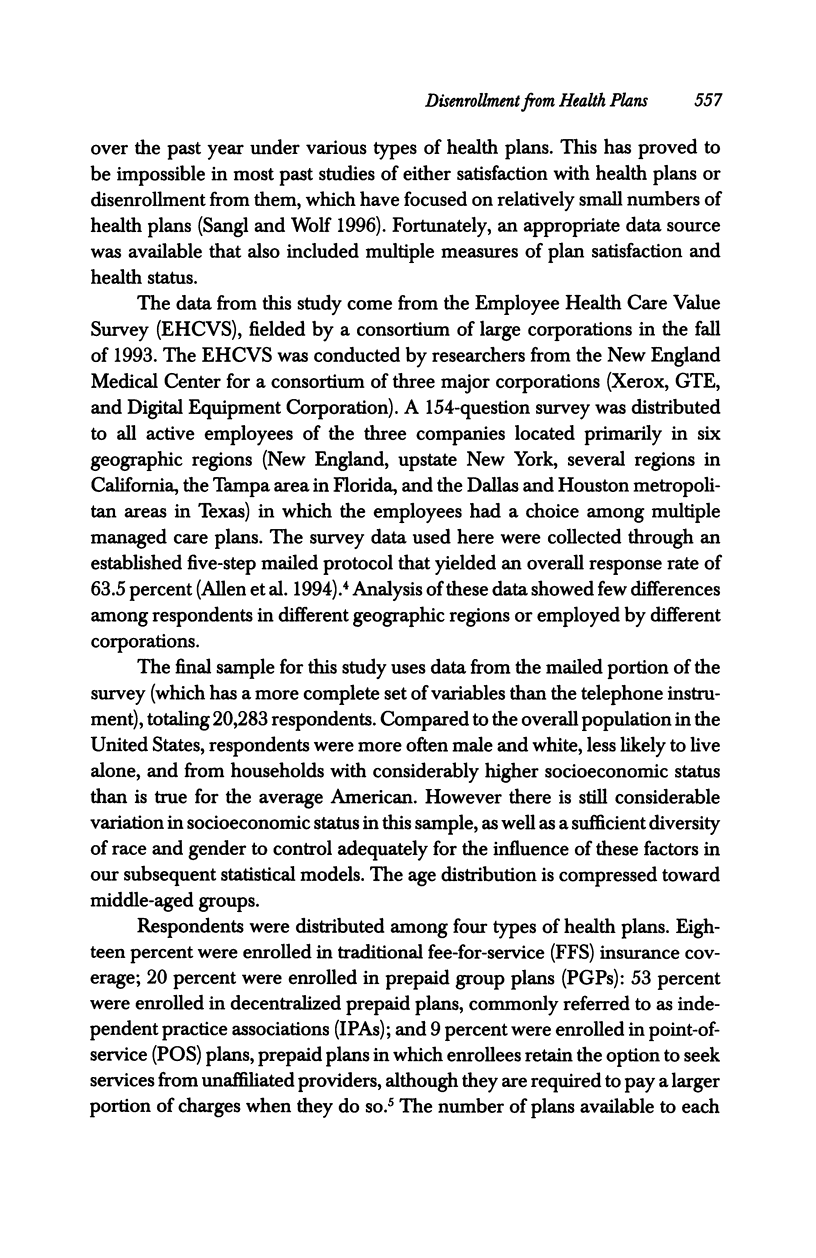
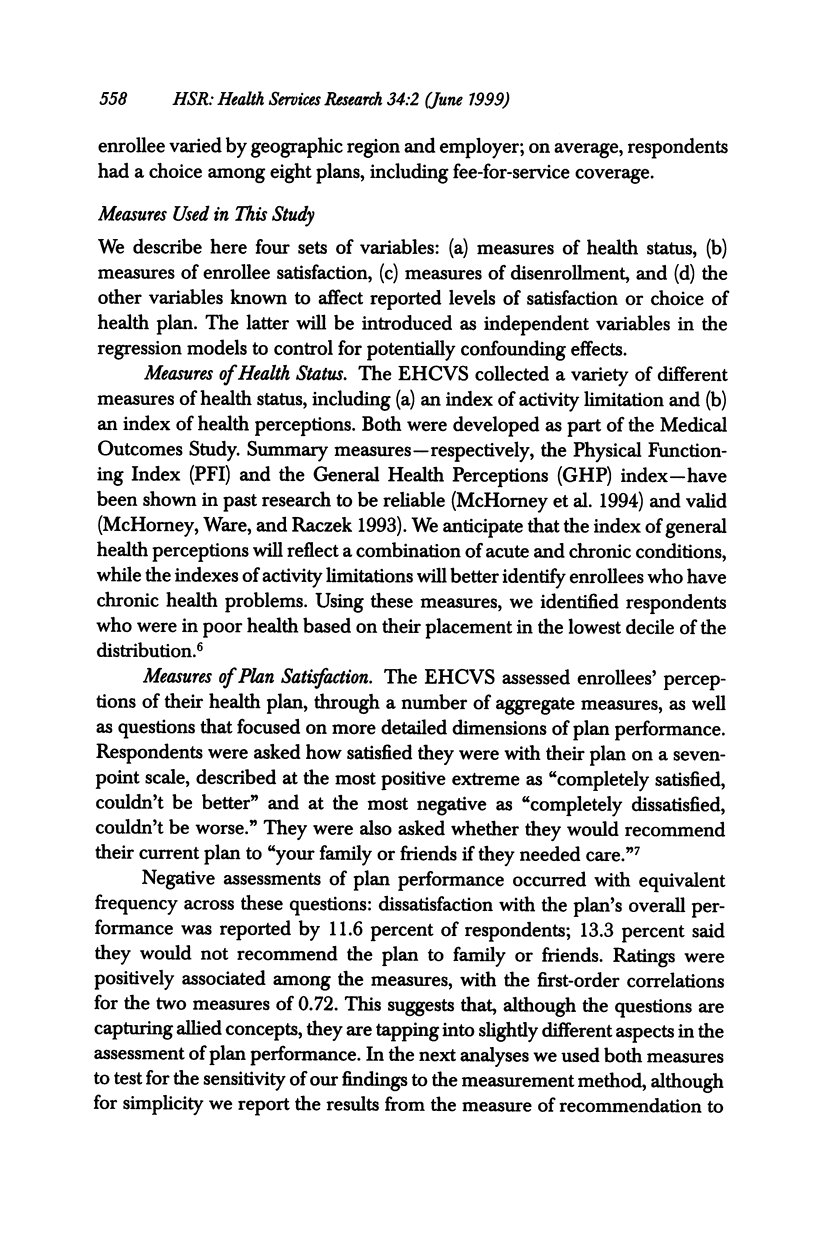
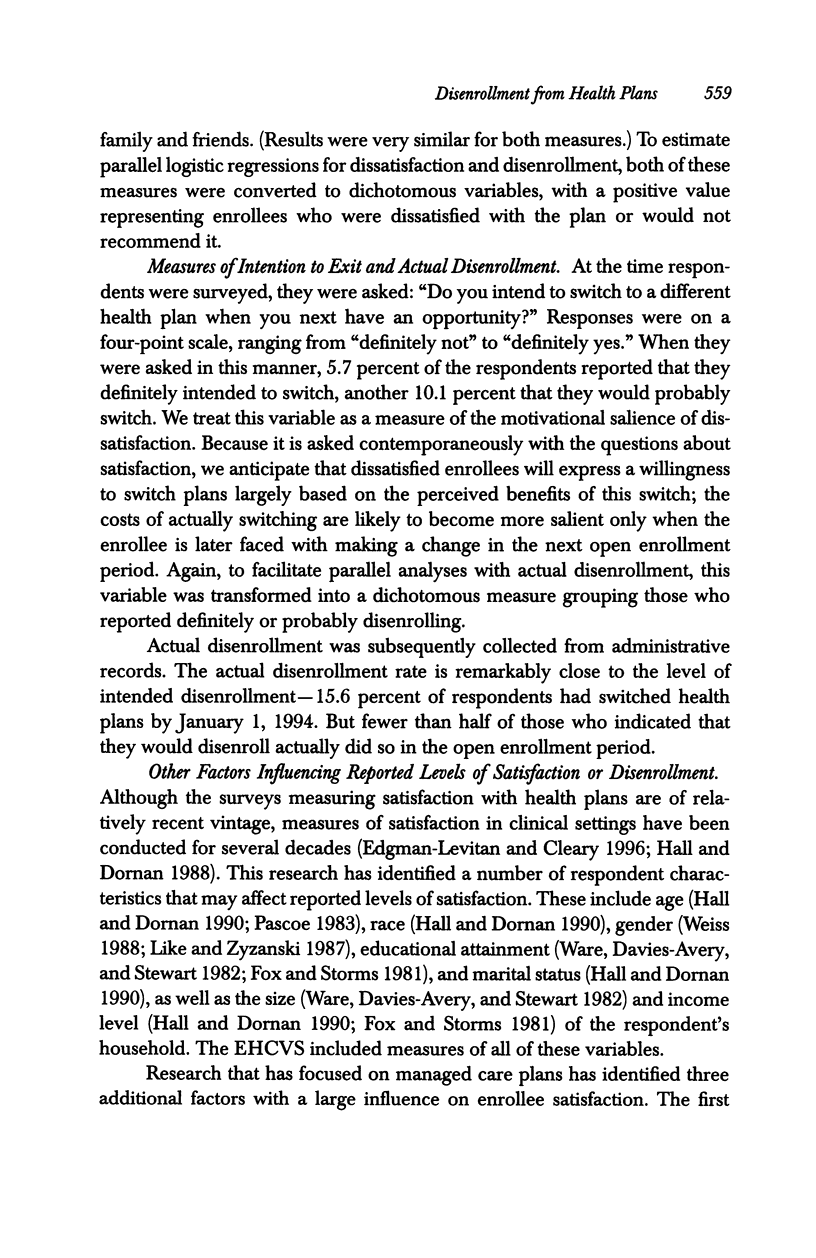
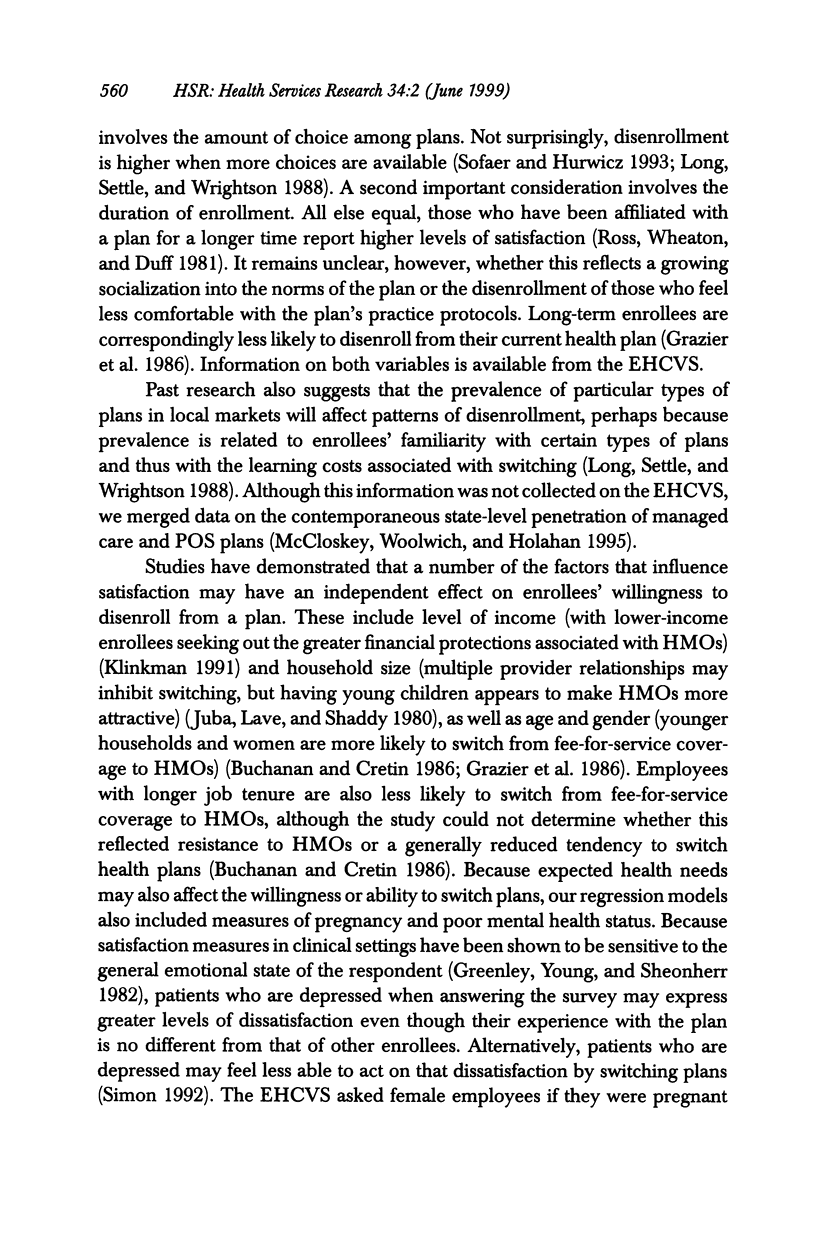
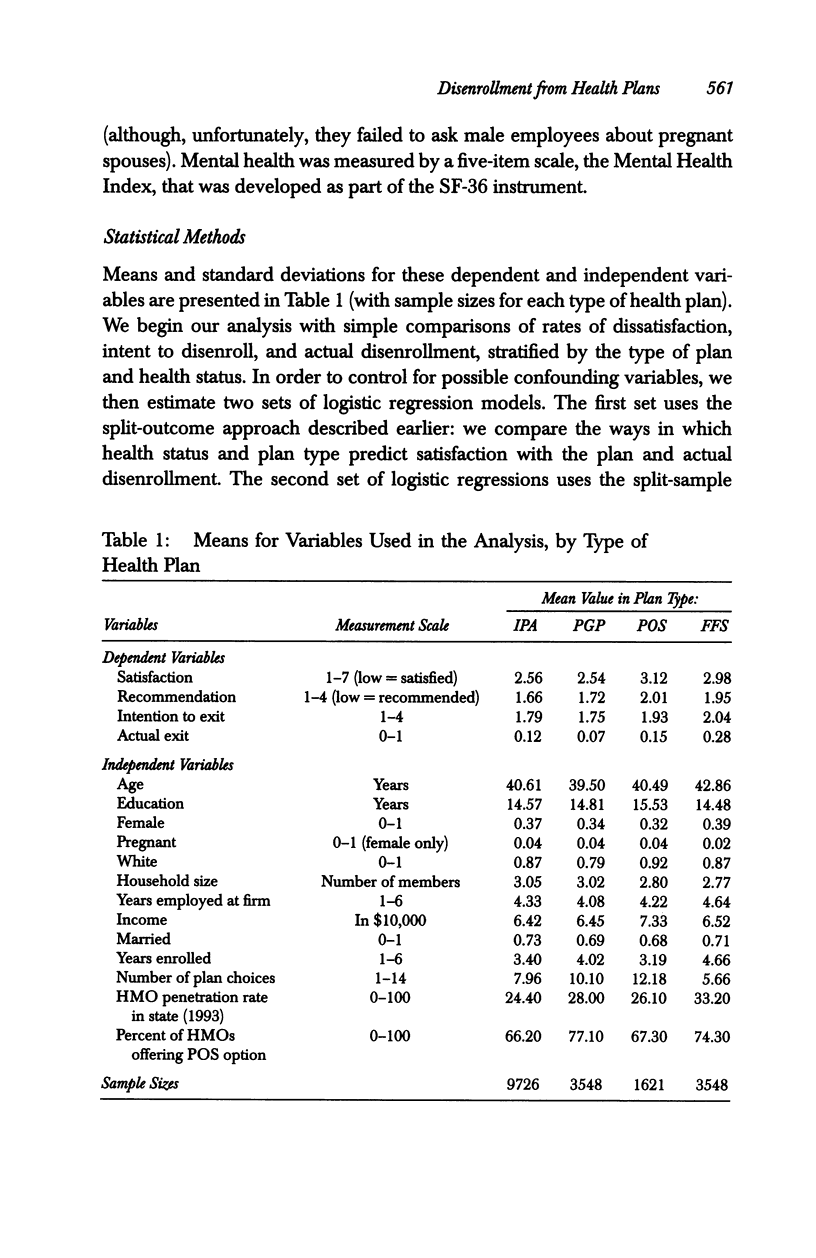
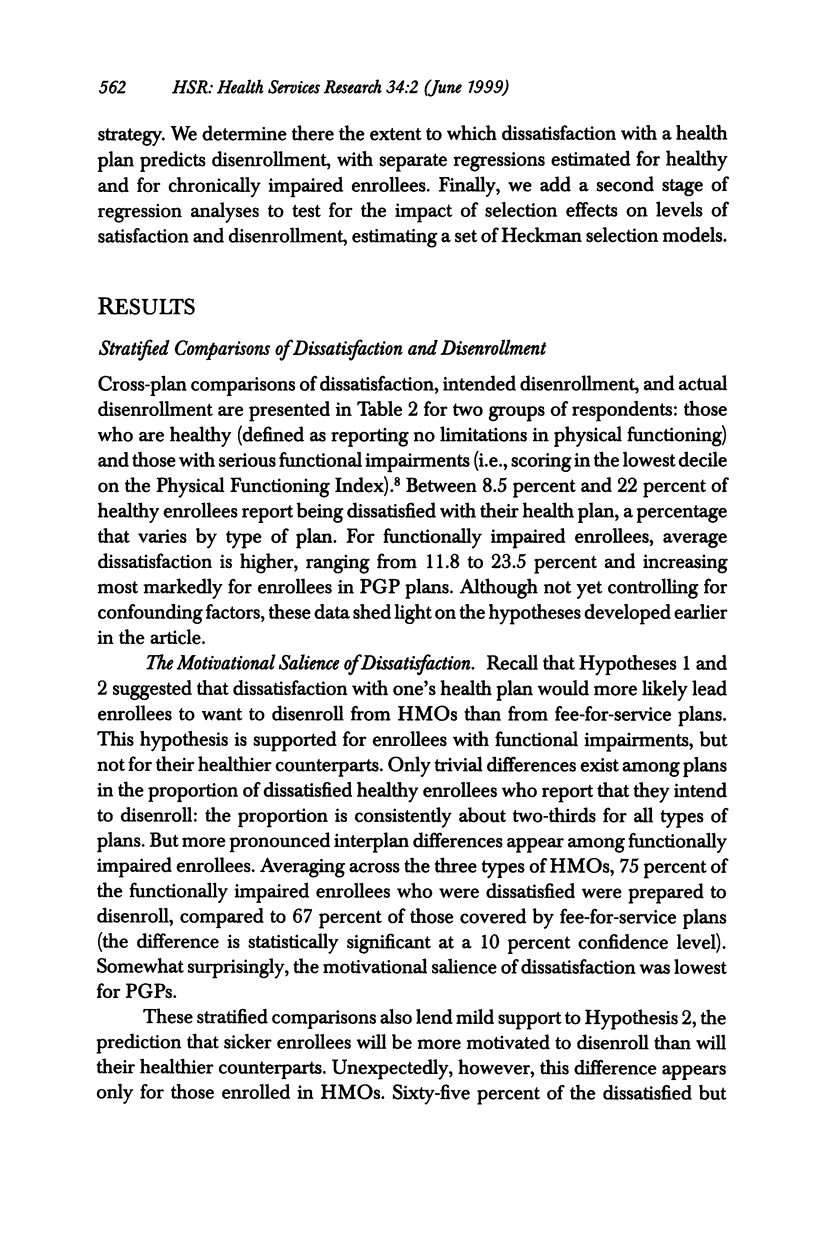
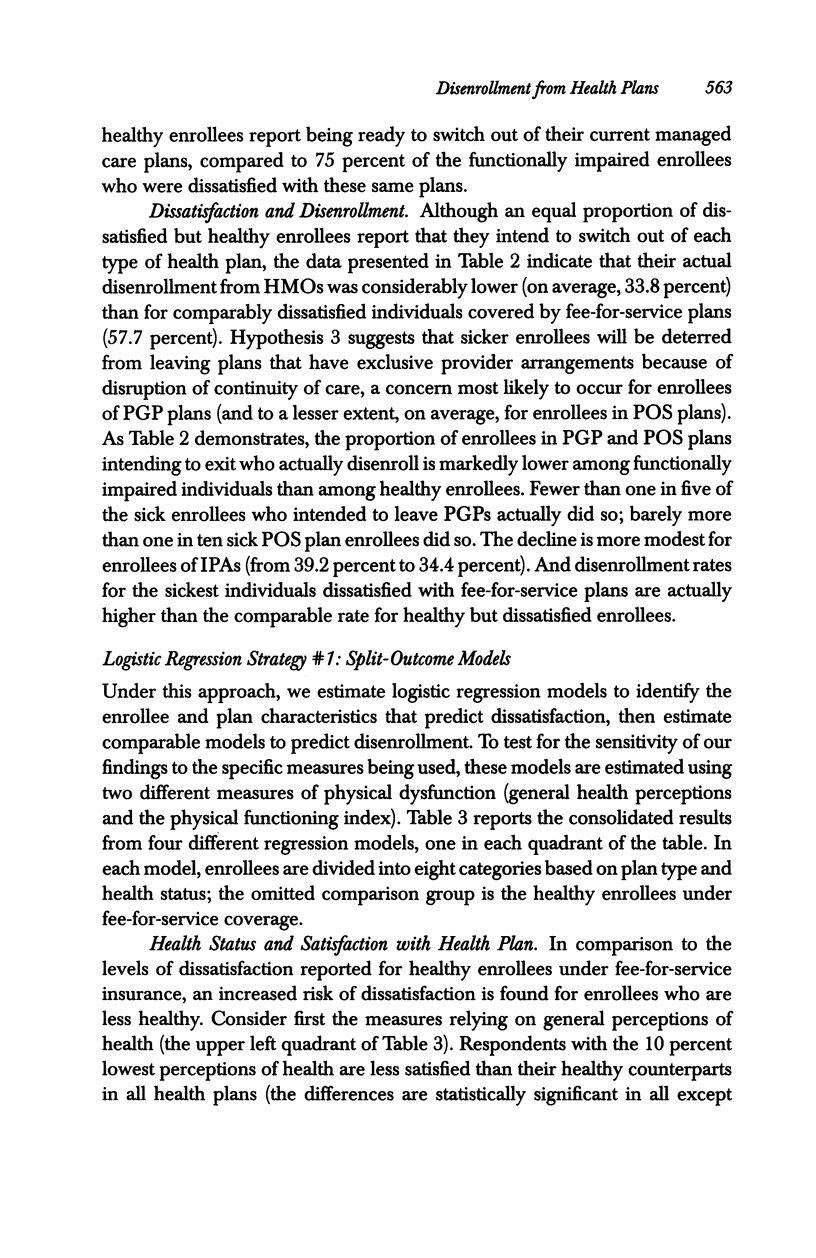

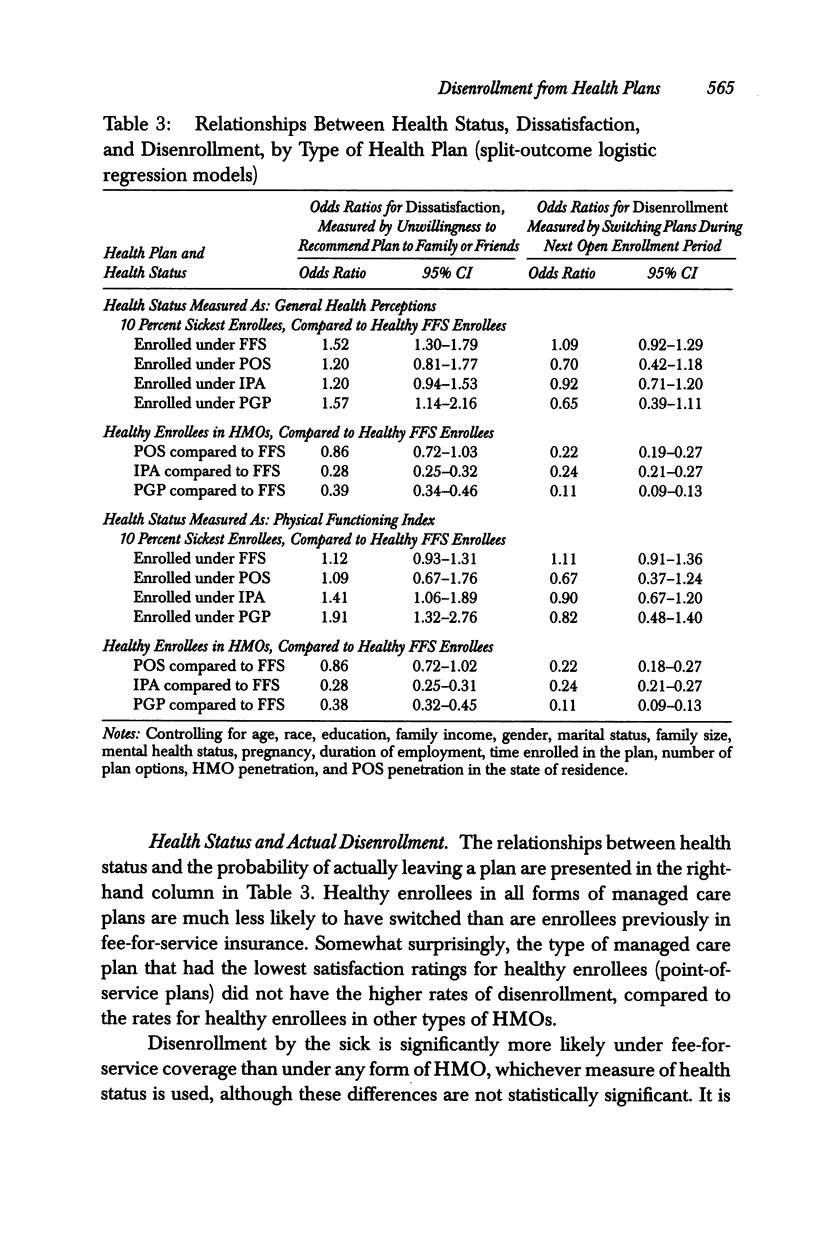
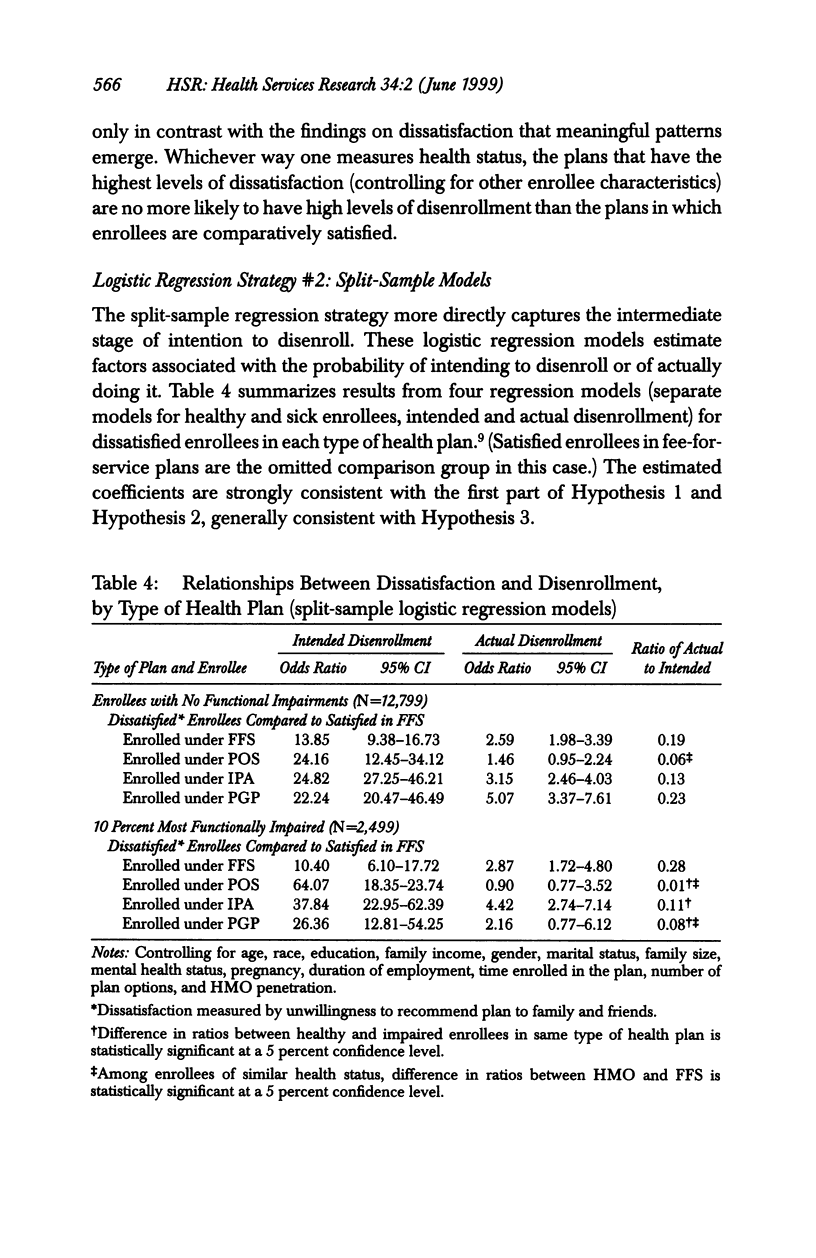

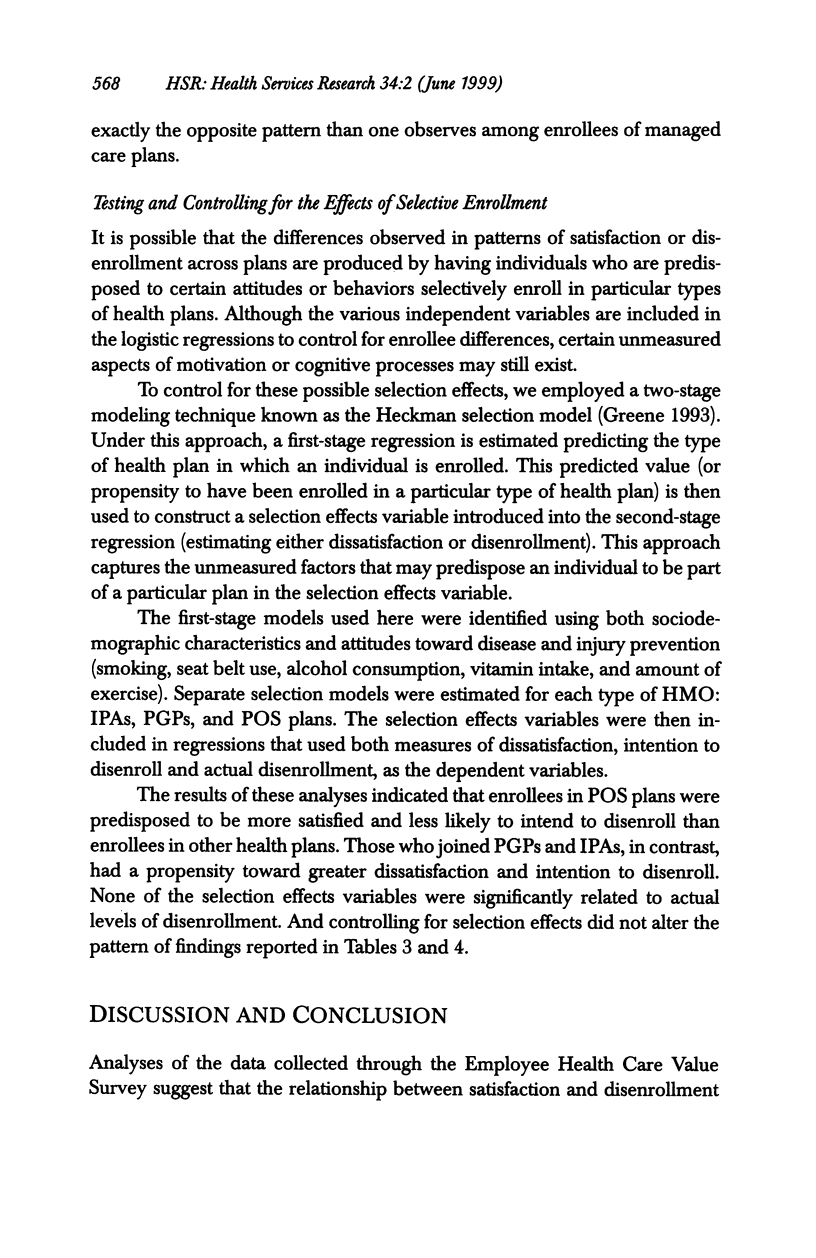
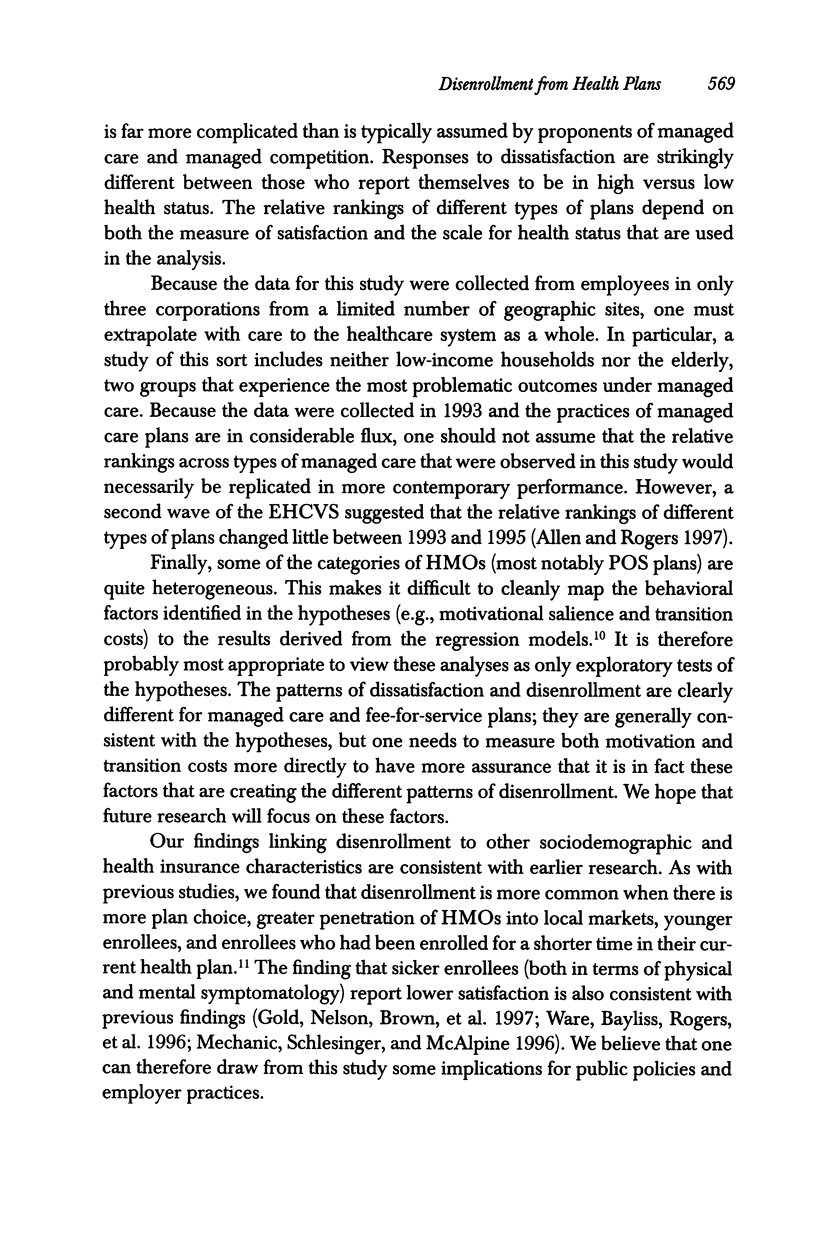
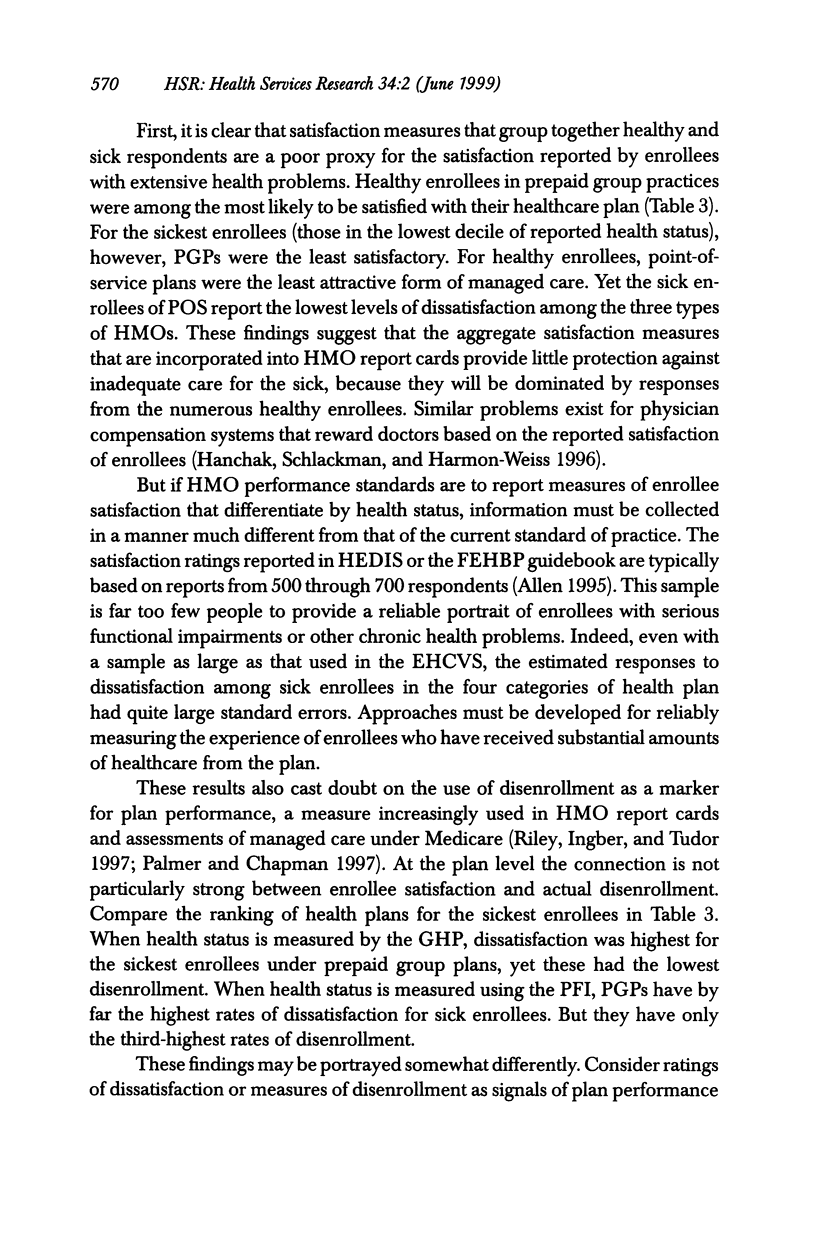
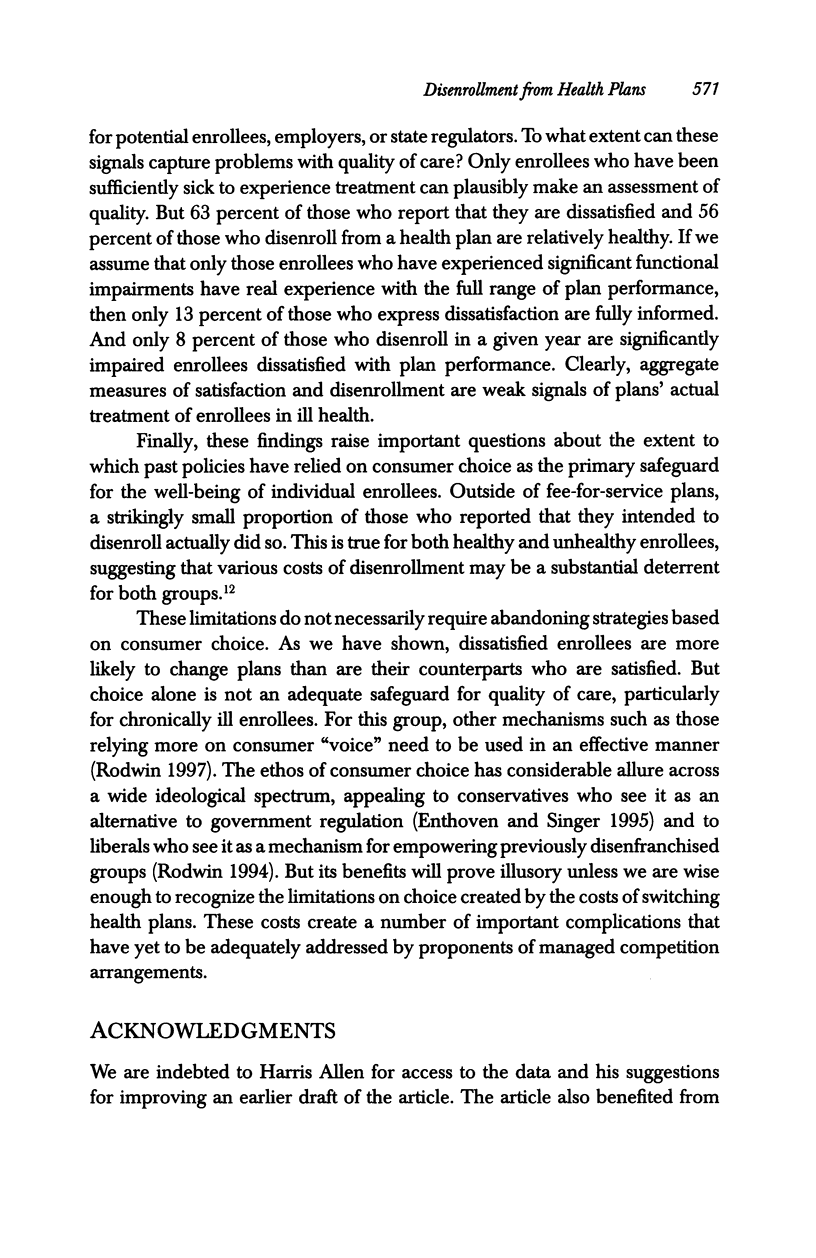
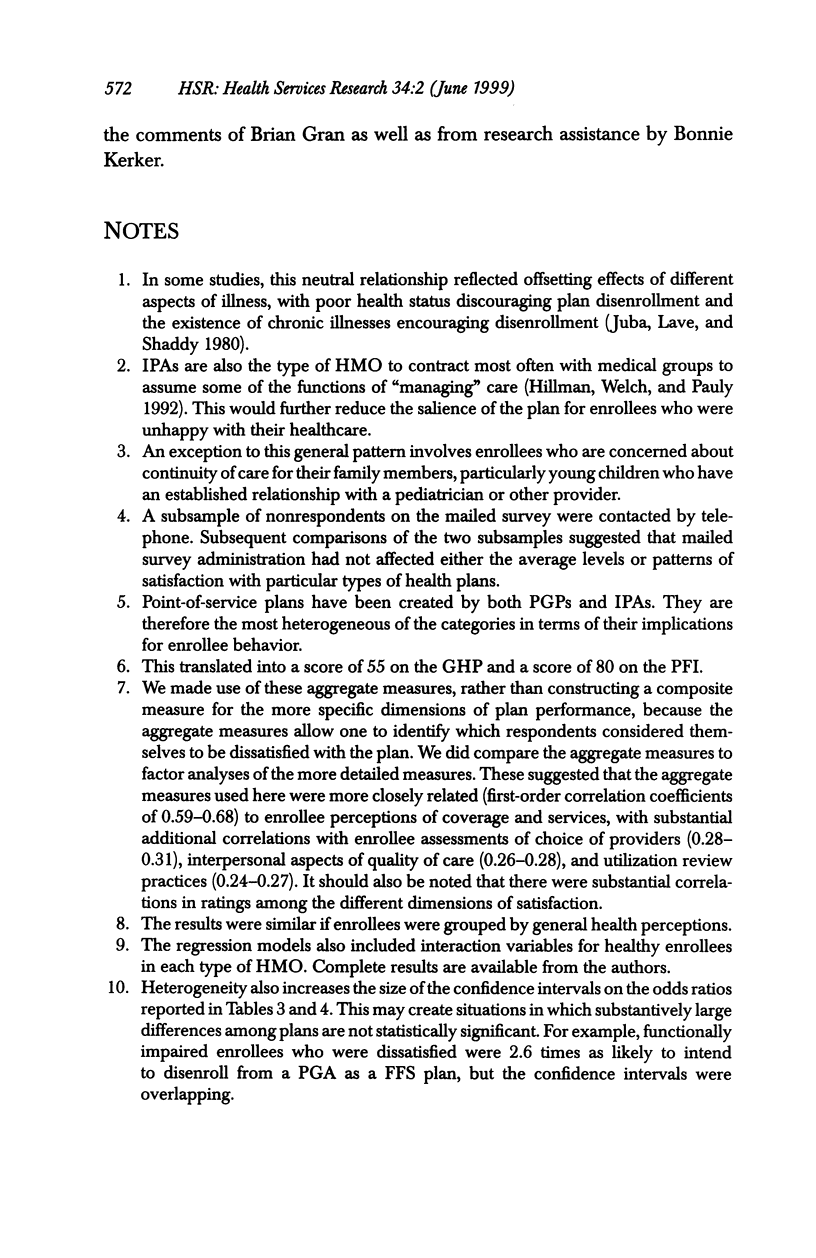
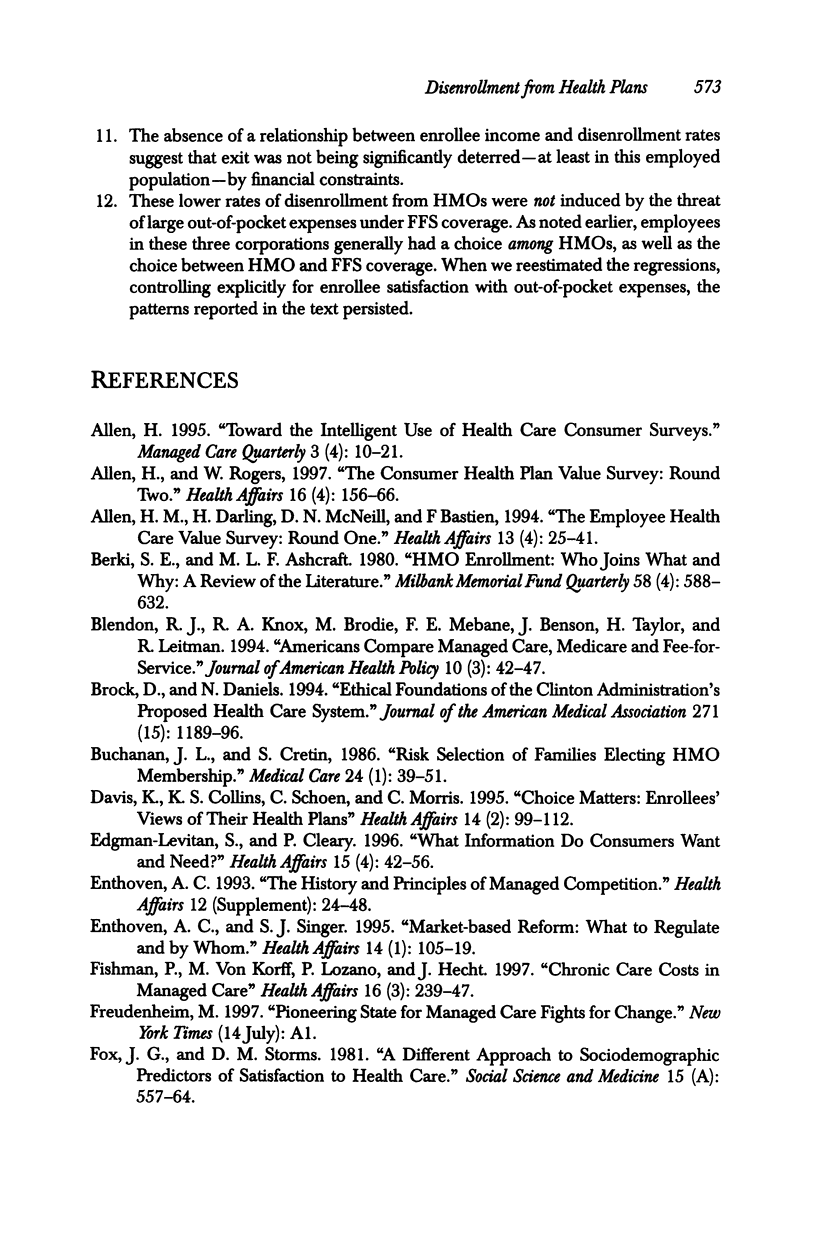
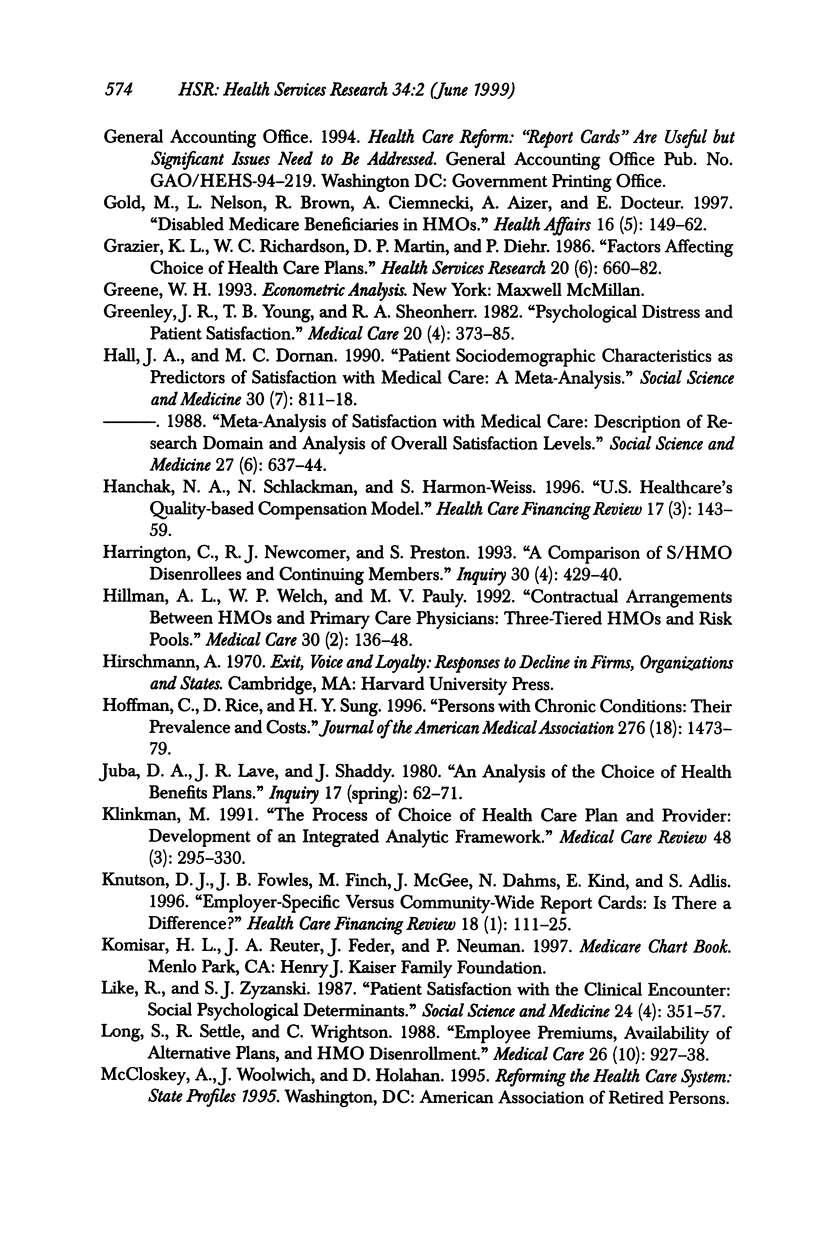
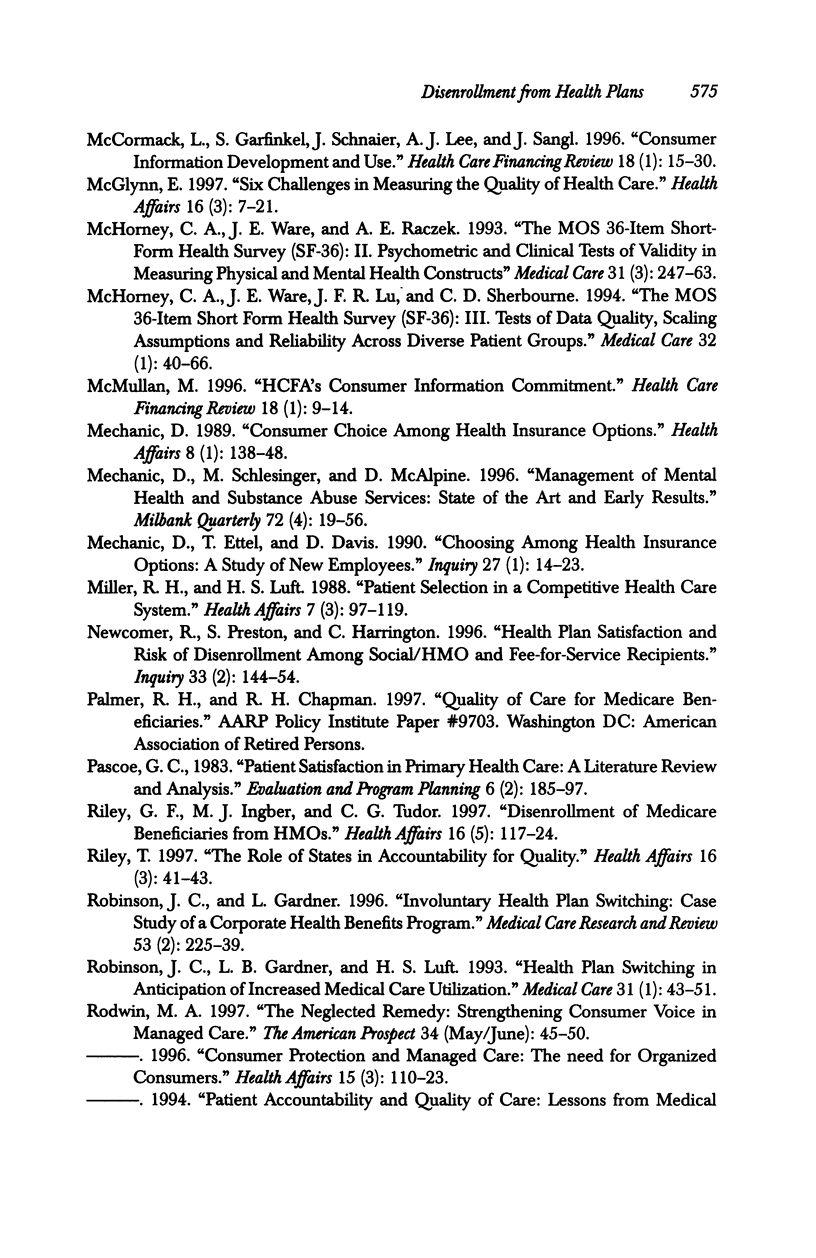
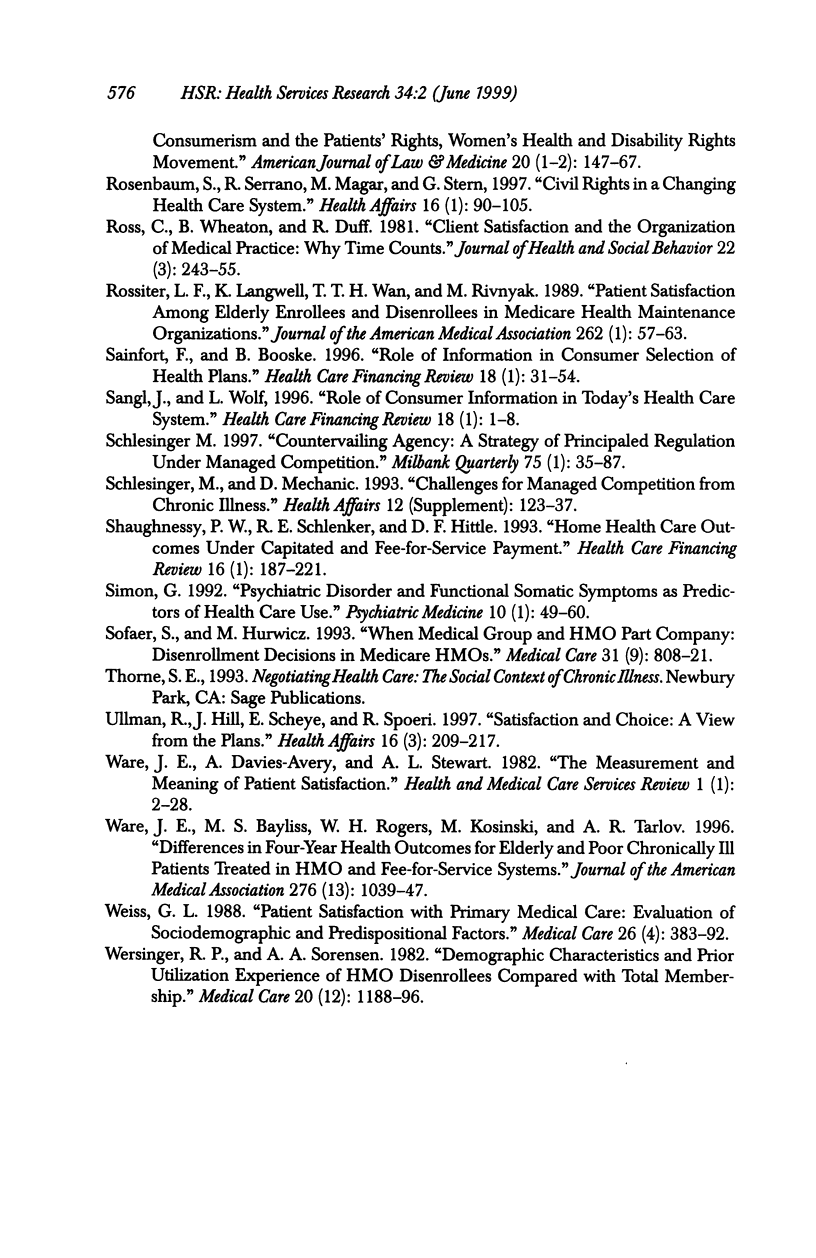
Selected References
These references are in PubMed. This may not be the complete list of references from this article.
- Allen H. M., Jr, Darling H., McNeill D. N., Bastien F. The Employee Health Care Value Survey: round one. Health Aff (Millwood) 1994 Fall;13(4):25–41. doi: 10.1377/hlthaff.13.4.25. [DOI] [PubMed] [Google Scholar]
- Allen H. M., Jr, Rogers W. H. The consumer health plan value survey: round two. Health Aff (Millwood) 1997 Jul-Aug;16(4):156–166. doi: 10.1377/hlthaff.16.4.156. [DOI] [PubMed] [Google Scholar]
- Allen H. M., Jr Toward the intelligent use of health care consumer surveys. Manag Care Q. 1995 Autumn;3(4):10–21. [PubMed] [Google Scholar]
- Berki S. E., Ashcraft M. L. HMO enrollment: who joins what and why: a review of the literature. Milbank Mem Fund Q Health Soc. 1980 Fall;58(4):588–632. [PubMed] [Google Scholar]
- Blendon R. J., Knox R. A., Brodie M., Benson J. M., Chervinsky G. Americans compare managed care, Medicare, and fee-for-service. J Am Health Policy. 1994 May-Jun;4(3):42–47. [PubMed] [Google Scholar]
- Brock D. W., Daniels N. Ethical foundations of the Clinton administration's proposed health care system. JAMA. 1994 Apr 20;271(15):1189–1196. [PubMed] [Google Scholar]
- Buchanan J. L., Cretin S. Risk selection of families electing HMO membership. Med Care. 1986 Jan;24(1):39–51. doi: 10.1097/00005650-198601000-00005. [DOI] [PubMed] [Google Scholar]
- Davis K., Collins K. S., Schoen C., Morris C. Choice matters: enrollees' views of their health plans. Health Aff (Millwood) 1995 Summer;14(2):99–112. doi: 10.1377/hlthaff.14.2.99. [DOI] [PubMed] [Google Scholar]
- Edgman-Levitan S., Cleary P. D. What information do consumers want and need? Health Aff (Millwood) 1996 Winter;15(4):42–56. doi: 10.1377/hlthaff.15.4.42. [DOI] [PubMed] [Google Scholar]
- Enthoven A. C., Singer S. J. Market-based reform: what to regulate and by whom. Health Aff (Millwood) 1995 Spring;14(1):105–119. doi: 10.1377/hlthaff.14.1.105. [DOI] [PubMed] [Google Scholar]
- Enthoven A. C. The history and principles of managed competition. Health Aff (Millwood) 1993;12 (Suppl):24–48. doi: 10.1377/hlthaff.12.suppl_1.24. [DOI] [PubMed] [Google Scholar]
- Fishman P., Von Korff M., Lozano P., Hecht J. Chronic care costs in managed care. Health Aff (Millwood) 1997 May-Jun;16(3):239–247. doi: 10.1377/hlthaff.16.3.239. [DOI] [PubMed] [Google Scholar]
- Fox J. G., Storms D. M. A different approach to sociodemographic predictors of satisfaction with health care. Soc Sci Med A. 1981 Sep;15(5):557–564. doi: 10.1016/0271-7123(81)90079-1. [DOI] [PubMed] [Google Scholar]
- Gold M., Nelson L., Brown R., Ciemnecki A., Aizer A., Docteur E. Disabled Medicare beneficiaries in HMOs. Health Aff (Millwood) 1997 Sep-Oct;16(5):149–162. doi: 10.1377/hlthaff.16.5.149. [DOI] [PubMed] [Google Scholar]
- Greenley J. R., Young T. B., Schoenherr R. A. Psychological distress and patient satisfaction. Med Care. 1982 Apr;20(4):373–385. doi: 10.1097/00005650-198204000-00003. [DOI] [PubMed] [Google Scholar]
- Hall J. A., Dornan M. C. Patient sociodemographic characteristics as predictors of satisfaction with medical care: a meta-analysis. Soc Sci Med. 1990;30(7):811–818. doi: 10.1016/0277-9536(90)90205-7. [DOI] [PubMed] [Google Scholar]
- Hanchak N. A., Schlackman N., Harmon-Weiss S. U.S. Healthcare's quality-based compensation model. Health Care Financ Rev. 1996 Spring;17(3):143–159. [PMC free article] [PubMed] [Google Scholar]
- Harrington C., Newcomer R. J., Preston S. A comparison of S/HMO disenrollees and continuing members. Inquiry. 1993 Winter;30(4):429–440. [PubMed] [Google Scholar]
- Hillman A. L., Welch W. P., Pauly M. V. Contractual arrangements between HMOs and primary care physicians: three-tiered HMOs and risk pools. Med Care. 1992 Feb;30(2):136–148. doi: 10.1097/00005650-199202000-00005. [DOI] [PubMed] [Google Scholar]
- Hoffman C., Rice D., Sung H. Y. Persons with chronic conditions. Their prevalence and costs. JAMA. 1996 Nov 13;276(18):1473–1479. [PubMed] [Google Scholar]
- Juba D. A., Lave J. R., Shaddy J. An analysis of the choice of health benefits plans. Inquiry. 1980 Spring;17(1):62–71. [PubMed] [Google Scholar]
- Klinkman M. S. The process of choice of health care plan and provider: development of an integrated analytic framework. Med Care Rev. 1991 Fall;48(3):295–330. doi: 10.1177/002570879104800304. [DOI] [PubMed] [Google Scholar]
- Knutson D. J., Fowles J. B., Finch M., McGee J., Dahms N., Kind E. A., Adlis S. Employer-specific versus community-wide report cards: is there a difference? Health Care Financ Rev. 1996 Fall;18(1):111–125. [PMC free article] [PubMed] [Google Scholar]
- Like R., Zyzanski S. J. Patient satisfaction with the clinical encounter: social psychological determinants. Soc Sci Med. 1987;24(4):351–357. doi: 10.1016/0277-9536(87)90153-5. [DOI] [PubMed] [Google Scholar]
- Long S. H., Settle R. F., Wrightson C. W., Jr Employee premiums, availability of alternative plans, and HMO disenrollment. Med Care. 1988 Oct;26(10):927–938. doi: 10.1097/00005650-198810000-00001. [DOI] [PubMed] [Google Scholar]
- Luft H. S., Miller R. H. Patient selection in a competitive health care system. Health Aff (Millwood) 1988 Summer;7(3):97–119. doi: 10.1377/hlthaff.7.3.97. [DOI] [PubMed] [Google Scholar]
- McCormack L. A., Garfinkel S. A., Schnaier J. A., Lee A. J., Sangl J. A. Consumer information development and use. Health Care Financ Rev. 1996 Fall;18(1):15–30. [PMC free article] [PubMed] [Google Scholar]
- McGlynn E. A. Six challenges in measuring the quality of health care. Health Aff (Millwood) 1997 May-Jun;16(3):7–21. doi: 10.1377/hlthaff.16.3.7. [DOI] [PubMed] [Google Scholar]
- McHorney C. A., Ware J. E., Jr, Lu J. F., Sherbourne C. D. The MOS 36-item Short-Form Health Survey (SF-36): III. Tests of data quality, scaling assumptions, and reliability across diverse patient groups. Med Care. 1994 Jan;32(1):40–66. doi: 10.1097/00005650-199401000-00004. [DOI] [PubMed] [Google Scholar]
- McHorney C. A., Ware J. E., Jr, Raczek A. E. The MOS 36-Item Short-Form Health Survey (SF-36): II. Psychometric and clinical tests of validity in measuring physical and mental health constructs. Med Care. 1993 Mar;31(3):247–263. doi: 10.1097/00005650-199303000-00006. [DOI] [PubMed] [Google Scholar]
- McMullan M. HCFA's consumer information commitment. Health Care Financ Rev. 1996 Fall;18(1):9–14. [PMC free article] [PubMed] [Google Scholar]
- Mechanic D. Consumer choice among health insurance options. Health Aff (Millwood) 1989 Spring;8(1):138–148. doi: 10.1377/hlthaff.8.1.138. [DOI] [PubMed] [Google Scholar]
- Mechanic D., Ettel T., Davis D. Choosing among health insurance options: a study of new employees. Inquiry. 1990 Spring;27(1):14–23. [PubMed] [Google Scholar]
- Newcomer R., Preston S., Harrington C. Health plan satisfaction and risk of disenrollment among social/HMO and fee-for-service recipients. Inquiry. 1996 Summer;33(2):144–154. [PubMed] [Google Scholar]
- Pascoe G. C. Patient satisfaction in primary health care: a literature review and analysis. Eval Program Plann. 1983;6(3-4):185–210. doi: 10.1016/0149-7189(83)90002-2. [DOI] [PubMed] [Google Scholar]
- Riley G. F., Ingber M. J., Tudor C. G. Disenrollment of Medicare beneficiaries from HMOs. Health Aff (Millwood) 1997 Sep-Oct;16(5):117–124. doi: 10.1377/hlthaff.16.5.117. [DOI] [PubMed] [Google Scholar]
- Riley T. The role of states in accountability for quality. Health Aff (Millwood) 1997 May-Jun;16(3):41–43. doi: 10.1377/hlthaff.16.3.41. [DOI] [PubMed] [Google Scholar]
- Robinson J. C., Gardner L. B. Involuntary health plan switching: case study of a corporate health benefits program. Med Care Res Rev. 1996 Jun;53(2):225–239. doi: 10.1177/107755879605300206. [DOI] [PubMed] [Google Scholar]
- Robinson J. C., Gardner L. B., Luft H. S. Health plan switching in anticipation of increased medical care utilization. Med Care. 1993 Jan;31(1):43–51. doi: 10.1097/00005650-199301000-00003. [DOI] [PubMed] [Google Scholar]
- Rosenbaum S., Serrano R., Magar M., Stern G. Civil rights in a changing health care system. Health Aff (Millwood) 1997 Jan-Feb;16(1):90–105. doi: 10.1377/hlthaff.16.1.90. [DOI] [PubMed] [Google Scholar]
- Ross C. E., Wheaton B., Duff R. S. Client satisfaction and the organization of medical practice: why time counts. J Health Soc Behav. 1981 Sep;22(3):243–255. [PubMed] [Google Scholar]
- Rossiter L. F., Langwell K., Wan T. T., Rivnyak M. Patient satisfaction among elderly enrollees and disenrollees in Medicare health maintenance organizations. Results from the National Medicare Competition Evaluation. JAMA. 1989 Jul 7;262(1):57–63. [PubMed] [Google Scholar]
- Sainfort F., Booske B. C. Role of information in consumer selection of health plans. Health Care Financ Rev. 1996 Fall;18(1):31–54. [PMC free article] [PubMed] [Google Scholar]
- Schlesinger M. Countervailing agency: a strategy of principaled regulation under managed competition. Milbank Q. 1997;75(1):35–87. doi: 10.1111/1468-0009.00044. [DOI] [PMC free article] [PubMed] [Google Scholar]
- Schlesinger M., Mechanic D. Challenges for managed competition from chronic illness. Health Aff (Millwood) 1993;12 (Suppl):123–137. doi: 10.1377/hlthaff.12.suppl_1.123. [DOI] [PubMed] [Google Scholar]
- Shaughnessy P. W., Schlenker R. E., Hittle D. F. Home health care outcomes under capitated and fee-for-service payment. Health Care Financ Rev. 1994 Fall;16(1):187–222. [PMC free article] [PubMed] [Google Scholar]
- Simon G. E. Psychiatric disorder and functional somatic symptoms as predictors of health care use. Psychiatr Med. 1992;10(3):49–59. [PubMed] [Google Scholar]
- Sofaer S., Hurwicz M. L. When medical group and HMO part company: disenrollment decisions in Medicare HMOs. Med Care. 1993 Sep;31(9):808–821. doi: 10.1097/00005650-199309000-00006. [DOI] [PubMed] [Google Scholar]
- Ullman R., Hill J. W., Scheye E. C., Spoeri R. K. Satisfaction and choice: a view from the plans. Health Aff (Millwood) 1997 May-Jun;16(3):209–217. doi: 10.1377/hlthaff.16.3.209. [DOI] [PubMed] [Google Scholar]
- Ware J. E., Jr, Bayliss M. S., Rogers W. H., Kosinski M., Tarlov A. R. Differences in 4-year health outcomes for elderly and poor, chronically ill patients treated in HMO and fee-for-service systems. Results from the Medical Outcomes Study. JAMA. 1996 Oct 2;276(13):1039–1047. [PubMed] [Google Scholar]
- Weiss G. L. Patient satisfaction with primary medical care. Evaluation of sociodemographic and predispositional factors. Med Care. 1988 Apr;26(4):383–392. doi: 10.1097/00005650-198804000-00007. [DOI] [PubMed] [Google Scholar]
- Wersinger R. P., Sorensen A. A. Demographic characteristics and prior utilization experience of HMO disenrollees compared with total membership. Med Care. 1982 Dec;20(12):1188–1196. doi: 10.1097/00005650-198212000-00005. [DOI] [PubMed] [Google Scholar]


